
Share
The Bayeux Tapestry Museum, which opened in its present form in 1983, is preparing to close its doors to the public on 1 September 2025. Work began in January on the project to renovate the museum, which has been the subject of discussions between the four institutional partners – the French State, the Normandy Region, the Calvados Department and the Town of Bayeux – over the last ten years. The main concern is to preserve one of the most precious pieces of 11th-century heritage, listed in UNESCO’s Memory of the World register and as a historic monument since 1840.

As the owner of the Bayeux Tapestry, the French government is carrying out an ambitious conservation programme for the thousand-year-old embroidery in parallel with the work to renovate the museum. Extensive work began in January 2025, with a meticulous dusting of the linen canvas and the removal of its technical backsplash at its reverse side, a fleece fabric affixed in 1983 which, although it protected the work of art on its reverse side, made it rigid and heavy.
The year 2025 marks the launch of an unprecedented project, led by the DRAC Normandie and involving eleven specialists in ancient textiles, both restorers and curators. This group of experts will be involved throughout the project, which will run until the work is returned to its future home in the new museum in 2027.
– January 2025: The splashback, which protects the reverse of the canvas, is removed for a complete dusting of the Tapestry, on its embroidered side and on its reverse lining. These works involve experts in textile restoration, operating in a specially equipped area to guarantee optimum conditions of safety and preservation.
– March-April 2025: During an exceptional closure of the museum from 31 March to 2 April, a facsimile of the Tapestry will be handled to test the logistical conditions with a view to removing the original work from its current display case in September, packing it in a conservation crate and transporting it to temporary storage.
– Spring-Summer 2025: archaeological excavations will be carried out on the site of the future building that will house the new Tapestry exhibition hall. Commissioned by the DRAC of Normandy, the aim of these excavations is to gain a better understanding of this historic site, which formed the enclosure of the former Grand Seminary, the actual museum.
– September 2025: The Tapestry will be carefully moved to a suitable storage area, where it will remain in supervised conservation until it is installed in its new home in autumn 2027.
In parallel with this schedule, which concerns conservation operations around the work, another schedule, that of the work on the future museum, brings together several interventions on the urban footprint of the new cultural establishment:
– February-March 2025: Trees will be felled around the perimeter of the future building and the ancient building at 15 rue aux coqs (the museum’s former storerooms) will be demolished. This loss of vegetation will be compensated for by planting nearly three times the number of trees removed, both on and off site.
– The current museum will close to the public on 31 August 2025. The work will remain inaccessible for the duration of the works. The shared objective is to complete the project with a view to opening the new Bayeux Tapestry Museum in 2027, to mark the millennium of the birth of William the Conqueror.
– From October 2025 to October 2027, after the Bayeux Tapestry has been removed for storage, the extension and renovation work will take place.

Adjacent to the building of the former Grand Séminaire (the current museum), a new building will house the Tapestry, which will now be installed behind a display case, on an inclined table measuring an extraordinary 70 metres in length. This state-of-the-art facility will ensure optimum presentation, respectful conservation and the essential restoration of the work later.
The design of this innovative table, which will mark a turning point in the history of the preservation of this masterpiece, was entrusted to a design studio specialising in the manufacture of sophisticated technical and artistic devices. Atelier BLAM was able to showcase its expertise at the opening ceremony of the Paris 2024 Olympic Games, with the creation of the mechanical horse galloping along the river Seine.
This unique creation will be produced with the expertise of FL & CO, a company specialising in preventive conservation, commissioned by RSHP, which is responsible for the architectural design of the future museum.
This ambitious project, costing 38 million euros (excluding VAT), benefits from funding guaranteed by an inter-regional State-Region planning contract (CPIER-CPER), which is shared between the four partners: the State, which owns the work, the Normandy Region, the Calvados Department and the town of Bayeux.